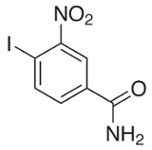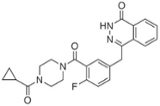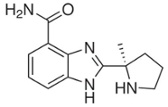Poly ADP Ribose Polymerase (PARP) Inhibitors are a group of compounds used in the treatment of cancer. They are unique in their ability to specifically target cancerous cells. PARP proteins are responsible for repairing single-strand breaks in DNA, and when inhibited result in double strand breaks during the raid DNA replication that is characteristic of cancers. This collection of double strand breaks will then cause the death of the cancerous cell. Normal, healthy cells, however, undergo replication slowly enough that the DNA may be repaired by other mechanisms such as through homologous repair, allowing them to survive the PARP inhibition.
Poly ADP Ribose Polymerase (PARP) Inhibitors are a group of compounds used in the treatment of cancer. They are unique in their ability to specifically target cancerous cells. PARP proteins are responsible for repairing single-strand breaks in DNA, and when inhibited result in double strand breaks during the raid DNA replication that is characteristic of cancers. This collection of double strand breaks will then cause the death of the cancerous cell. Normal, healthy cells, however, undergo replication slowly enough that the DNA may be repaired by other mechanisms such as through homologous repair, allowing them to survive the PARP inhibition. Certain cancers in particular are much more dependent on PARP than regular cells, making them good targets for chemotherapeutic cancer therapy by PARP inhibitors. For example, PARP inhibitors are especially effective in the case of cancers caused by BRCA mutations. BRCA1 and BRCA2 are responsible for proteins that help in DNA repair themselves, and mutated forms of these genes can cause some types of cancer by letting errors in DNA amass. In cancer cells where this is the case, inhibiting PARP in combination with the innate initial strain on cell repair thanks to the nature of the BRCA mutations causes cell death. NEW PARP INHIBITORS 1. Iniparib: PARP Inhbitor that is being studied as a treatment for pancreatic cancer.
2. Olaparib: Found to have strong potential against breast, ovarian, and colorectal cancer.

3. Veliparib: A good candidate for treating metastic melanoma, as well as breast cancer.

REFERENCES:
- Piskunova TS, Yuorva MN, et al. Curr. Gerontol. Geriatr. Res. 754190 (2008).
- Hall JM, Lee MK, et al. Science. 250:1684-89(1990).
- Fogelman DR., Wolff RA., et al. Anticancer Res. (4): 1417-20 (2011).
- Fong PC, Boss DS, et al. N. Engl. J. Med. 361(2):123-34 (2009).
- Isakoff SJ, Overmoyer NM, et al. J. Clin. Oncol. 28:15s (2010).
